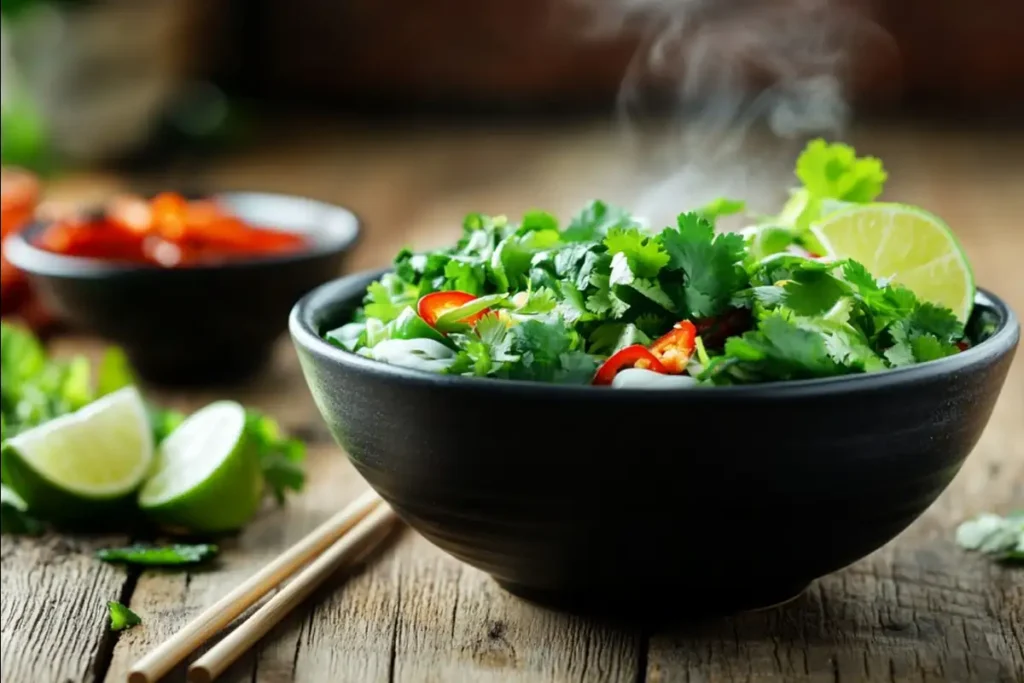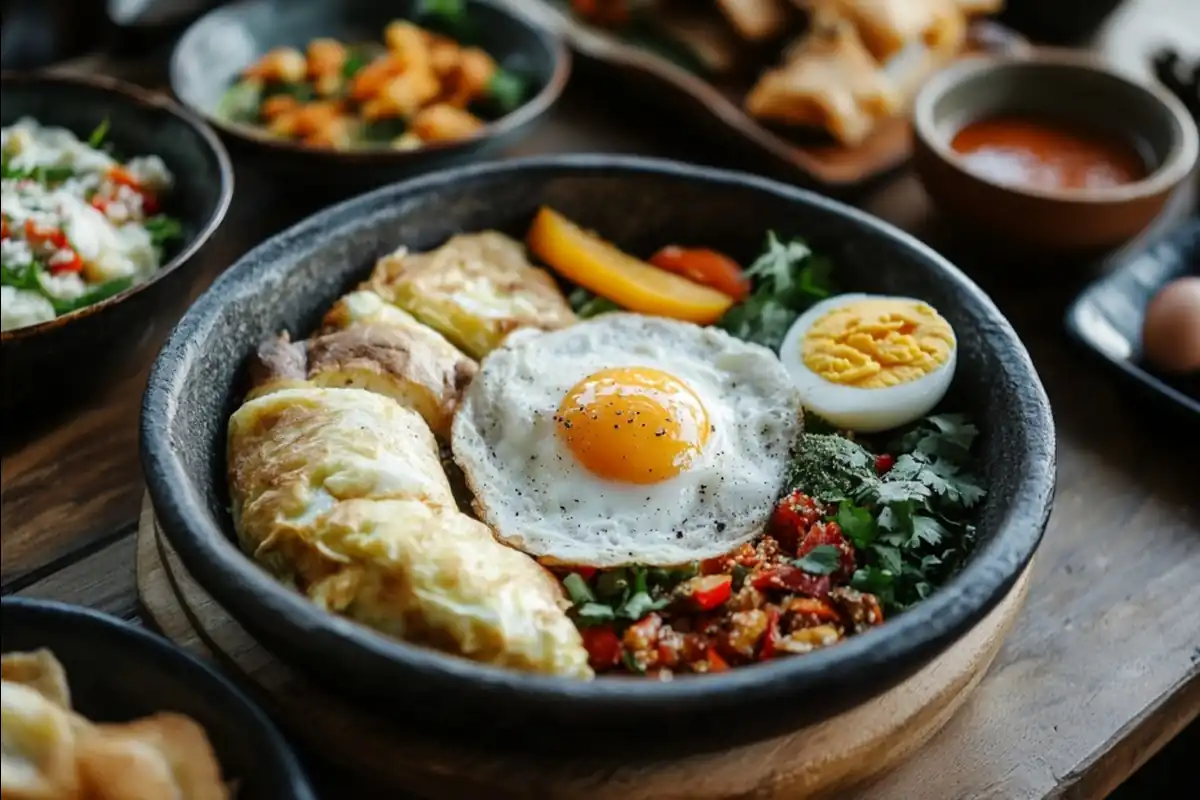Introduction
When it comes to the first meal of the day, Asia offers a tapestry of diverse, flavorful, and culturally rich options. From the fragrant spices of Chole Bhature in India to the delicate layers of Jianbing in China, breakfast in Asia isn’t just a meal—it’s an experience. This article explores the question, “What Is a Typical Asian Breakfast?”, diving deep into regional specialties, common ingredients, traditional recipes, and the nutritional significance of these meals.
By the end of this article, you’ll not only know what constitutes a typical Asian breakfast but also understand the cultural, social, and culinary importance of these dishes. So, let’s embark on this delicious journey!
1: What Defines a Typical Asian Breakfast?
What Defines a Typical Asian Breakfast?
Asia, a continent of diverse cultures, languages, and traditions, reflects this variety in its breakfasts. A typical Asian breakfast is often hearty, vibrant, and tailored to the climate, agricultural practices, and cultural preferences of the region. While some breakfasts focus on rice and soups, others lean toward bread, pancakes, or porridge.
Breakfast in Asia isn’t just about filling up; it’s often a communal event, shared among family or friends, symbolizing togetherness. Whether it’s sipping on Turkish tea during a leisurely Kahvaltı or grabbing a hot bowl of Vietnamese Pho on the way to work, breakfast is deeply rooted in the rhythms of daily life.
Cultural Significance of Breakfast in Asia
Unlike in the West, where breakfast is often quick and on-the-go, Asian breakfasts emphasize a balance of flavors and textures—sweet, salty, spicy, and umami. These meals frequently include fermented or pickled foods, which are believed to aid digestion and boost overall health.
Additionally, Asian breakfasts often tell stories. For instance, a Turkish Katmer, traditionally eaten by newlyweds, signifies hope and sweetness in marriage. In Vietnam, Bánh mì represents a harmonious blend of Eastern and Western influences.
Common Themes Across Asia
While the dishes vary widely, several common themes emerge across Asian breakfasts:
- Rice or rice-based dishes are staples in many regions, such as Japan’s steamed rice and Indonesia’s Nasi Goreng.
- Flatbreads and pancakes, like India’s stuffed Paratha or China’s crispy Jianbing, are popular.
- Soups and broths play a key role, from Pho in Vietnam to Miso Soup in Japan.
- Vegetables and pickled sides add crunch and acidity, balancing heavier dishes.
- Hot beverages, such as tea or soy milk, accompany meals in most regions.
2: Traditional Asian Breakfasts by Region
East Asia
Breakfasts in East Asia celebrate simplicity and balance, often pairing warm dishes with light accompaniments.
- Chinese Breakfast: Jianbing and You Tiao
The classic Chinese breakfast often features Jianbing, a savory pancake layered with egg, scallions, and sauces, offering a perfect crunch and chew. Paired with You Tiao (fried dough sticks) and soy milk, this meal is a street food favorite.
Explore similar savory recipes that might inspire your next meal. - Japanese Breakfast: Miso Soup and Rice
Japan’s breakfast staples include steamed rice, miso soup, and grilled fish. A side of natto (fermented soybeans) or pickled vegetables complements this nutritionally balanced meal. - Korean Breakfast: Kimchi Jjigae
In Korea, breakfasts often revolve around soups. Kimchi Jjigae, a spicy stew made with fermented kimchi, tofu, and pork, is commonly enjoyed with rice and side dishes like pickled radishes.
Southeast Asia
This region’s breakfasts are vibrant, featuring spices and tropical ingredients.
- Vietnamese Pho and Banh Mi
Pho, a hearty noodle soup brimming with herbs and proteins, is a staple in Vietnam. For something portable, Banh Mi, a baguette filled with meats and pickled vegetables, offers a delightful fusion of French and Vietnamese flavors. - Indonesian Bubur Ayam and Nasi Goreng
Bubur Ayam (chicken congee) is a comforting, savory porridge topped with fried shallots and boiled eggs. Another favorite, Nasi Goreng, is a fragrant fried rice dish perfect for fueling the day. - Malaysian Roti Canai and Nasi Lemak
Malaysia’s famed Roti Canai, a flaky flatbread, is often served with dhal or curry. For a more indulgent option, try Nasi Lemak, featuring coconut rice, sambal, and fried anchovies.
South Asia
In South Asia, breakfasts are bold and aromatic, often combining legumes, bread, and spices.
- Indian Paratha and Chole Bhature
Paratha, a flatbread stuffed with spiced fillings like potatoes or paneer, is a beloved morning dish, typically served with yogurt and pickles. For a richer option, Chole Bhature pairs spicy chickpeas with deep-fried bread. - Sri Lankan Hoppers and Pol Sambol
Sri Lanka offers Hoppers—bowl-shaped pancakes made with fermented rice flour and coconut milk—often accompanied by Pol Sambol, a fiery coconut relish.
Middle East and Central Asia
These regions bring bold spices and rich textures to the breakfast table.
- Turkish Kahvaltı
A traditional Kahvaltı spread includes olives, cheeses, jams, eggs, and freshly baked bread, complemented by endless glasses of Turkish tea. - Arabic Fatteh and Lahm Bi Ajin
In the Arab world, Fatteh combines torn flatbread, chickpeas, and yogurt for a hearty start. Meanwhile, Lahm Bi Ajin (meat pies) offer a savory treat with minced lamb and spices baked on thin dough.
3: Popular Ingredients in Asian Breakfasts
Rice and Rice-Based Dishes
Rice forms the backbone of many Asian breakfasts, whether as steamed rice in Japan or as part of Bubur Ayam in Indonesia. Its versatility allows it to be savory, sweet, or even both in the same meal.
Flatbreads and Pancakes
Flatbreads like India’s Paratha and Malaysia’s Roti Canai provide comfort and versatility, often paired with curries, chutneys, or yogurts. Similarly, pancakes such as China’s Jianbing are portable and flavorful.
Soups and Stews
Soups like Pho and Kimchi Jjigae are morning favorites in Vietnam and Korea, delivering warmth and nourishment in every bite. These dishes are perfect examples of the functional yet flavorful nature of Asian breakfasts.
Eggs and Protein Dishes
Eggs appear frequently, whether fried, boiled, or in omelets. Japanese rolled omelets, tamago, and Indian Anda Bhurji (spiced scrambled eggs) are standout examples.
Vegetables and Pickles
Pickles and fermented vegetables, such as Korean kimchi or Japanese pickled radishes, not only enhance flavor but also provide a probiotic boost. These additions are as healthy as they are delicious.
This variety of ingredients highlights the diversity of what is a typical Asian breakfast, showcasing its depth and deliciousness. With this array of staples, there’s a breakfast dish for every palate!
4: Recipes for Authentic Asian Breakfasts
Recipe for Jianbing (Chinese Pancakes)

Jianbing is a quintessential Chinese street food and an answer to what is a typical Asian breakfast. Here’s how to make it at home:
Ingredients:
- 1 cup all-purpose flour
- 1/2 cup mung bean flour
- 2 eggs
- 1/4 cup water
- Soybean paste, chili sauce
- Scallions, sesame seeds, and crispy wonton skins for topping
Instructions:
- Mix the flours and water to form a smooth batter.
- Heat a non-stick pan and pour a ladle of batter, spreading it thinly.
- Crack an egg on top, spreading it evenly.
- Add sauces and sprinkle toppings.
- Fold into a pocket and serve warm.
For more breakfast ideas, you might like our Chicken Pita Recipe.
How to Make Roti Canai (Malaysia)
Roti Canai is a Malaysian breakfast classic, often paired with curry or dhal.
Ingredients:
- 2 cups all-purpose flour
- 1/2 tsp salt
- 1/4 cup ghee or vegetable oil
- 1/2 cup water
Instructions:
- Mix flour, salt, and ghee. Gradually add water and knead into a soft dough.
- Rest for an hour, then divide into small balls.
- Flatten each ball, spread with oil, and fold into layers.
- Fry in a skillet until golden.
Traditional Chole Bhature Recipe (India)
This Indian dish combines spicy chickpeas (chole) with fluffy, deep-fried bread (bhature).
Chole Ingredients:
- 1 cup chickpeas (soaked overnight)
- 1 onion, 1 tomato (pureed)
- 1 tsp garam masala, cumin, and coriander powder
Bhature Ingredients:
- 2 cups all-purpose flour
- 1/2 cup yogurt
- 1/2 tsp baking soda
Instructions:
- Cook chickpeas with spices until soft.
- For bhature, knead a dough with flour, yogurt, and baking soda.
- Roll into discs and deep fry until puffed.
Quick Guide to Turkish Kahvaltı

Kahvaltı isn’t just a meal—it’s a lavish spread of cheeses, olives, eggs, and breads. Add a warm glass of Turkish tea, and you’re ready for the day.
Ingredients:
- Feta cheese, olives, cherry tomatoes, cucumbers
- Freshly baked bread or simit
- Honey and clotted cream for sweetness
Instructions: Arrange everything on a platter and enjoy with tea.
5: Variations of Asian Breakfasts
Street Food vs. Homemade
Street food breakfast dishes like Jianbing or Vietnamese Pho are quick, affordable, and full of flavor. These options cater to the busy lives of city dwellers. On the other hand, homemade breakfasts, such as Korean Kimchi Jjigae or Japanese Tamago, allow for personalization and are often more balanced.
For an exciting twist, explore ways to customize your breakfast with these delicious recipes.
Fusion Breakfasts
Fusion breakfasts blend traditional flavors with modern techniques. For example, adding a Western twist to Nasi Lemak by incorporating scrambled eggs or avocado creates a delightful blend of cuisines.
Regional Adaptations
Asian breakfast dishes adapt to local ingredients and cultural preferences. For instance, Indian Parathas can be stuffed with regional vegetables like spinach or radish, while Bubur Ayam in Indonesia might feature locally available spices.
Such adaptations highlight the versatility of what is a typical Asian breakfast, ensuring there’s always a new flavor to discover!
With these recipes and variations, you’re all set to bring the heart of Asia to your breakfast table. Whether you’re a fan of street food or crave a cozy homemade meal, Asian breakfasts offer something for everyone.
6: Benefits of Asian Breakfasts
Nutritional Benefits
Asian breakfasts are often celebrated for their nutritional balance. Meals like Vietnamese Pho or Indian Parathas combine proteins, carbohydrates, and vegetables to provide a well-rounded start to the day. Ingredients such as rice, lentils, and fermented vegetables, which are staples across the continent, are packed with essential vitamins, fiber, and probiotics.
Moreover, dishes like Korean Kimchi Jjigae include fermented components that support gut health. Similarly, the variety of spices used in meals like Chole Bhature offer not only flavor but also numerous health benefits, from boosting immunity to improving digestion.
Cultural and Social Benefits
Breakfast in many Asian cultures is more than just food; it’s a chance to connect. Whether it’s gathering around a table for a Turkish Kahvaltı or sharing street food like Chinese Jianbing, breakfast fosters social bonds. These communal meals often reflect the values of togetherness and hospitality central to many Asian traditions.
Sustainability and Local Sourcing
Asian breakfasts often rely on locally sourced ingredients, which means they’re not only fresh but also environmentally friendly. Dishes like Indonesian Bubur Ayam or Thai rice porridge utilize local produce and traditional cooking techniques, reducing the carbon footprint associated with processed foods.
These benefits, combined with the sheer variety of options, underscore the appeal of exploring what is a typical Asian breakfast. It’s clear that these meals nourish both the body and the spirit.
7: FAQs
What Is a Normal Asian Breakfast?
A normal Asian breakfast can vary widely, but it often includes staples like rice, noodles, or flatbreads paired with vegetables, proteins, and flavorful condiments. For example, a Japanese breakfast might include steamed rice and miso soup, while in India, you’ll find dishes like Idli or Paratha. These meals are designed to be satisfying and energizing.
What Is the Most Popular Breakfast Food in Asia?
While it’s hard to pick just one, dishes like Nasi Lemak in Malaysia, Pho in Vietnam, and Jianbing in China are among the most beloved. These dishes represent the heart of what is a typical Asian breakfast—flavorful, nourishing, and deeply rooted in tradition.
What Is a Traditional Chinese Breakfast Called?
In China, breakfast isn’t confined to one dish. Commonly referred to as Zǎocān (早餐), traditional breakfasts might include Jianbing, You Tiao, or congee. Each region adds its unique twist, making Chinese breakfasts incredibly diverse.
Do Asians Eat Eggs for Breakfast?
Yes, eggs are a common feature in many Asian breakfasts. From Japanese rolled omelets (tamago) to Indian spiced scrambled eggs (Anda Bhurji), eggs are versatile and nutritious, fitting seamlessly into various dishes.
8: Exploring the Diversity of Asian Breakfasts
The Unique Flavors of Asian Breakfasts
One of the most exciting aspects of what is a typical Asian breakfast is its incredible diversity. Each country and region has its unique approach, creating a breakfast culture that reflects local ingredients, traditions, and tastes. For example, in Japan, breakfast emphasizes simplicity and balance, with dishes like steamed rice and grilled fish paired with miso soup. In contrast, Indian breakfasts are rich and bold, featuring spiced flatbreads like Parathas or savory lentil cakes like Idli.
Asian breakfasts often incorporate a mix of sweet, savory, and spicy flavors, ensuring there’s something for everyone. Whether it’s a sweet Turkish Katmer filled with pistachios or a spicy bowl of Korean Kimchi Jjigae, these meals are designed to awaken the senses and energize the body.
Global Influence and Adaptations
Asian breakfast dishes have transcended borders, becoming popular worldwide. Iconic options like Vietnamese Pho or Chinese Jianbing are now beloved far beyond their countries of origin. These dishes have inspired countless adaptations, blending traditional flavors with modern twists to suit different palates.
Exploring the diversity of Asian breakfasts offers a window into the culinary traditions and cultural values of the region. It also answers the question, “What is a typical Asian breakfast?”, by showcasing how these meals are both deeply traditional and endlessly adaptable.
9: Bringing Asian Breakfasts to Your Table
Simple Ways to Start
You don’t need to travel far to enjoy the flavors of Asia in your breakfast routine. Many dishes, like Indonesian Bubur Ayam or Indian Chole Bhature, are surprisingly simple to prepare at home with a few basic ingredients. Experimenting with recipes from different regions is a fun and delicious way to expand your culinary skills.
Incorporating Asian Elements
For a quick Asian-inspired breakfast, start small. Add miso soup or pickled vegetables to your meal for a Japanese touch. Pair scrambled eggs with chili sauce or soy for a fusion twist. Over time, you can build a repertoire of authentic recipes, making dishes like Malaysian Roti Canai or Turkish Kahvaltı a staple in your kitchen.
Embracing the variety of what is a typical Asian breakfast allows you to savor new flavors and appreciate the cultural significance of these meals. With a little creativity and effort, you can turn your breakfast table into a global culinary adventure!


5 thoughts on “What Is a Typical Asian Breakfast? Exploring Diverse Flavors and Traditions”